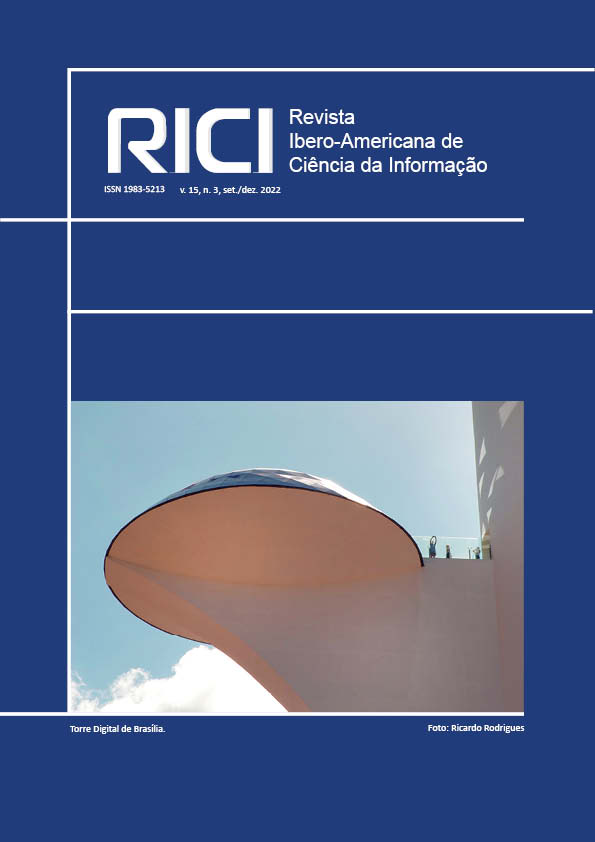Regulatory Framework to Combat Fake News in Brazil: an analysis of legislative proposals
DOI:
https://doi.org/10.26512/rici.v15.n3.2022.45659Keywords:
Internet, Fake news, Communication and information policies, BrazilAbstract
The objective of this research is to analyze the bills that are being processed in the National Congress that concern the fight against fake news in Brazil. Especially since the 2018 elections, and even more so with the 2022 elections, the debate on the subject has been intensifying, as well as the establishment of mechanisms for the mass production and reproduction of this false content with the intention of confusing Brazilians with respect to topics of paramount importance to the country, such as the treatment for Covid-19. To carry out this analysis, we used as a methodological procedure the Content Analysis, by Laurence Bardin (1977), to analyze the 50 bills, which were being processed in the Chamber and the Federal Senate, until 2021, highlighting in these projects the following aspects: thematic; concept; vocation for prevention or criminalization. As main results, it was found that most of the bills were built from the year 2020. It was also identified that there is a consensus regarding the concept of fake news, in such projects, which concerns fake news with the intention of causing harm. Most of the projects analyzed were linked to the topic of Covid-19 or the topic of elections, showing how these issues are sensitive and must be protected from the damage that false news can cause. Finally, most of these bills do not find a solution to the issue of fake news other than criminalization, other aspects that could be considered, such as education for the prevention and confrontation of this phenomenon, are almost never mentioned.
Downloads
References
BARDIN, Laurence. Análise do Conteúdo. Lisboa: Edições 70, 1977.
BRASIL. CÂMARA DOS DEPUTADOS. Portal da Câmara dos Deputados. 2020. Disponível em: https://www.camara.leg.br/
BRASIL. CÂMARA DOS DEPUTADOS. Portal da Câmara dos Deputados. 2019. Disponível em: https://www.camara.leg.br/
BRASIL. TRIBUNAL SUPERIOR ELEITORAL. Código Eleitoral. Brasília: Tribunal Superior Eleitoral, 2018.
EMPOLI, Giuliano da. Os engenheiros do Caos – como as Fake News, as teorias da conspiração e os algoritmos estão sendo utilizados para disseminar ódio, medo e influenciar eleições. São Paulo: Vestígio, 2019.
FONSECA JÚNIOR, W. C. Análise de Conteúdo. In: DUARTE, J.; BARROS, A. (Orgs.). Métodos e Técnicas de Pesquisa em Comunicação. 2. ed. São Paulo: Atlas, 2009. p. 280-303.
LOPES, Ivonete da Silva; LEAL, Daniela de Ulysséa. Entre a pandemia e o negacionismo: a comunicação de riscos da covid-19 pelo governo brasileiro. Chasqui. Revista Latinoamericana de Comunicación, [S.L.], v. 1, n. 145, p. 261-280, 21 dez. 2020. CIESPAL. Disponível em: https://revistachasqui.org/index.php/chasqui/article/view/4350
MARCONI, Marina A.; LAKATOS, Eva M.. Fundamentos de Metodologia Científica. São Paulo : Atlas 2003.
MELLO, Patrícia C. A máquina do ódio: Notas de uma repórter sobre fake news e violência digital. São Paulo: Companhia das Letras, 2020.
MENESES, João Paulo. Sobre a necessidade de conceptualizar o fenómeno das fakes news. Observatorio (OBS). n. 1, pa. 37-53, 2018. Disponível em: https://dialnet.unirioja.es/servlet/articulo?codigo=6648894
MENESES, João Paulo. Como as leis estão a definir (e a criminalizar) as fake news. Comunicação Pública. v. 14, n. 27, 2019. Disponível em: https://journals.openedition.org/cp/5423?lang=es
POYNTER. A guide to anti-misinformation actions around the world. Disponível em: https://www.poynter.org/ifcn/anti-misinformation-actions/
SANTAELLA, Lucia. A semiótica das fake news. Verbum - Cadernos de Pós-Graduação, v. 9, n. 2, 2020. Disponível em: https://revistas.pucsp.br/index.php/verbum/article/view/50522
WOLF, Mauro. Teorias das comunicações de massa. São Paulo: Martins Fontes, 1985.
Downloads
Published
How to Cite
Issue
Section
License
Copyright (c) 2022 Janara Sousa, Ana Novelli, Giulia Castro

This work is licensed under a Creative Commons Attribution 4.0 International License.
Copyright Notice
Authors who publish in this journal agree to the following terms:
- Authors retain copyright and grant the journal right of first publication with the work simultaneously licensed under the Creative Commons Attribution License 4.0, allowing the sharing of work and recognition of the work of authorship and initial publication in this journal.
- Authors are able to take on additional contracts separately, non-exclusive distribution of the version of the paper published in this journal (ex.: distribute to an institutional repository or publish as a book), with an acknowledgment of its initial publication in this journal.
- Authors are permitted and encouraged to distribute their work online (eg.: in institutional repositories or on their website) at any point before or during the editorial process, as it can lead to productive exchanges, as well as increase the impact and citation the published work.
















